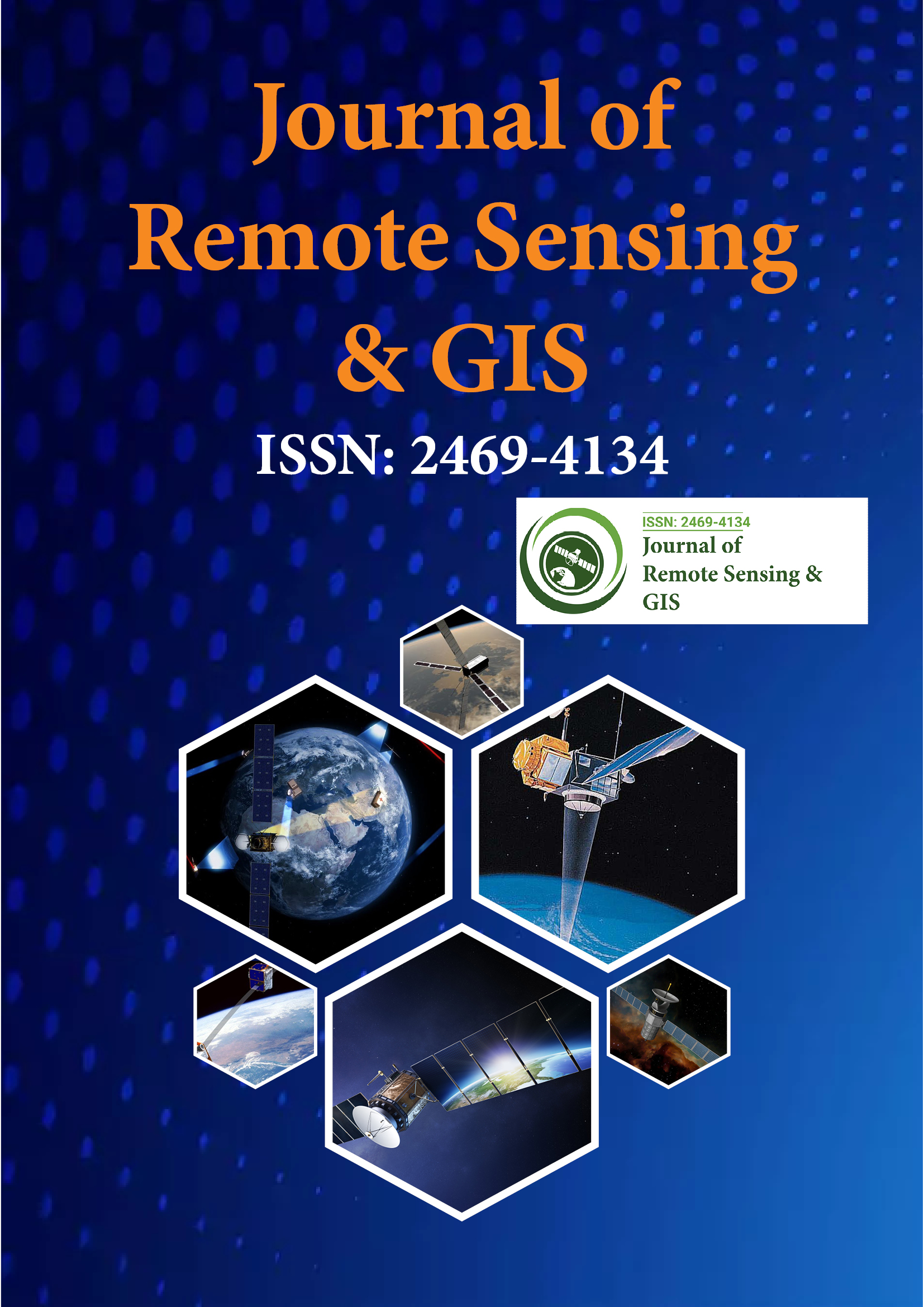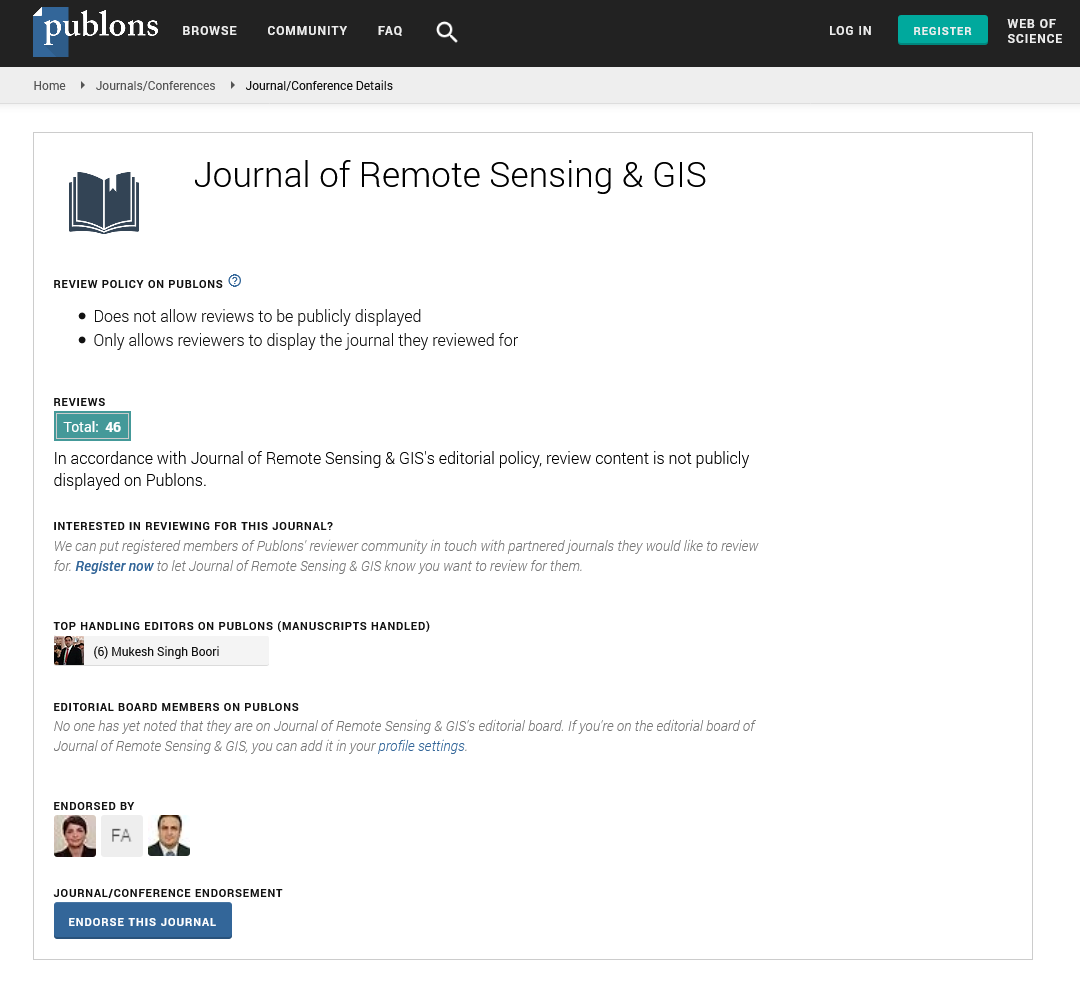Indexed In
- Open J Gate
- RefSeek
- Hamdard University
- EBSCO A-Z
- OCLC- WorldCat
- Publons
- International Scientific Indexing
- Euro Pub
- Google Scholar
Useful Links
Share This Page
Journal Flyer

Open Access Journals
- Agri and Aquaculture
- Biochemistry
- Bioinformatics & Systems Biology
- Business & Management
- Chemistry
- Clinical Sciences
- Engineering
- Food & Nutrition
- General Science
- Genetics & Molecular Biology
- Immunology & Microbiology
- Medical Sciences
- Neuroscience & Psychology
- Nursing & Health Care
- Pharmaceutical Sciences
Perspective - (2025) Volume 14, Issue 2
Urban Sprawl Analysis Using Multi-Temporal Satellite Imagery
Guo Peng*Received: 06-Jun-2025, Manuscript No. JGRS-25-29357; Editor assigned: 09-Jun-2025, Pre QC No. JGRS-25-29357 (PQ); Reviewed: 23-Jun-2025, QC No. JGRS-25-29357; Revised: 30-Jun-2025, Manuscript No. JGRS-25-29357 (R); Published: 07-Jul-2025, DOI: 10.35248/2469-4134.24.14.384
Description
Urban sprawl refers to the unplanned and low-density expansion of urban areas into surrounding rural lands, often accompanied by environmental degradation, infrastructure strain, and loss of agricultural space. Monitoring and analyzing the growth patterns of cities over time is essential for understanding the consequences of such expansion and for informing sustainable urban planning. Multi-temporal satellite imagery provides a consistent and effective means to observe and quantify changes in land cover and urban footprint across different time periods.
Remote sensing allows for repetitive and objective observation of the Earth’s surface, capturing detailed information on land use dynamics. The use of multi-temporal datasets-images acquired at different dates enables researchers and planners to detect changes in built-up areas, vegetation cover, and surface features associated with urbanization. By comparing satellite imagery across a series of years or decades, the spatial progression of urban growth can be mapped and analyzed.
Landsat satellite missions, operational since the 1970s, have played a central role in long-term urban sprawl analysis. The 30-meter spatial resolution of Landsat data is suitable for identifying broad land cover changes, especially in medium to large cities. More recently, Sentinel-2 data has improved the resolution to 10 meters, offering enhanced detail for rapidly growing urban areas and peri-urban regions. Commercial satellites, such as WorldView and PlanetScope, provide even finer detail and are useful for smaller-scale assessments or detailed city planning.
The process typically begins with the classification of satellite images into various land cover categories, such as built-up areas, vegetation, water bodies, and bare soil. Supervised classification techniques, including maximum likelihood, support vector machines, and random forest algorithms, are used to generate land cover maps from spectral data. Accuracy assessments are performed using ground truth data or high-resolution reference imagery to ensure reliable classification.
Once land cover maps are created for different time periods, change detection techniques are applied to assess urban expansion. Post-classification comparison is a widely used method where classified images from two or more dates are compared pixel by pixel to identify transitions from non-urban to urban categories. The results reveal not only the extent of urban growth but also its spatial pattern whether it occurs in a radial, linear, or leapfrog manner. These spatial characteristics have implications for infrastructure planning, transportation networks, and environmental impact.
Urban sprawl is often associated with the fragmentation of natural landscapes and the encroachment on agricultural lands. By quantifying the loss of vegetation and open spaces, satellite-based analysis can inform policymakers about the ecological consequences of unchecked growth. For example, shrinking green cover and increasing impervious surfaces affect local climate, groundwater recharge, and air quality. These trends can be monitored over time using indices such as the Normalized Difference Built-up Index (NDBI) and Normalized Difference Vegetation Index (NDVI).
Spatial metrics derived from remote sensing data provide additional insights into the structure and configuration of urban growth. These metrics include measures of patch density, edge length, and landscape diversity, which help describe how compact or dispersed a city has become. GIS platforms are used to analyze and visualize these metrics, supporting spatial planning efforts aimed at improving land use efficiency and reducing urban sprawl.
The integration of socio-economic data with remote sensing results enhances the understanding of drivers behind urban expansion. Population density, income distribution, housing policies, and transportation infrastructure are commonly linked to spatial growth patterns. By overlaying census data or infrastructure maps with classified satellite imagery, planners can explore the relationship between urban development and demographic trends.
One of the key applications of urban sprawl analysis is the formulation of zoning regulations and growth boundaries. Planners use satellite-derived land cover maps to assess compliance with existing regulations and to identify areas where development exceeds planned limits. Similarly, floodplain encroachment, construction in environmentally sensitive zones, and informal settlements can be identified using time-series imagery. These insights support the enforcement of land use policies and the prioritization of infrastructure development in growing urban fringes.
In addition to long-term planning, real-time monitoring of construction and land use change is increasingly being adopted by municipal authorities. Frequent and high-resolution satellite data allows for near-continuous observation of urban dynamics. This capability is especially important in rapidly growing cities where development can outpace traditional monitoring systems. Automated change detection algorithms now make it possible to detect new buildings, road networks, and land clearance activities soon after they occur.
Despite its strengths, remote sensing-based urban analysis has limitations. Mixed pixels in coarser-resolution images can reduce classification accuracy in densely built or heterogeneous areas. Cloud cover, especially in tropical regions, may limit optical imagery availability. Advances in radar-based sensors, which can acquire data regardless of weather or lighting, are helping to address some of these limitations. Ground verification remains essential to validate results and ensure the relevance of satellite-derived insights.
In conclusion, multi-temporal satellite imagery provides a powerful means of analyzing urban sprawl and understanding its spatial and environmental implications. By capturing the patterns and pace of urban growth, remote sensing supports data-driven urban planning and management. From identifying land use change to evaluating the loss of green cover, satellite-based analysis offers a comprehensive view of the challenges posed by unregulated expansion. When combined with GIS and socio-economic data, it enables informed decisions that can guide sustainable and equitable urban development. As urban populations continue to grow, the importance of timely and accurate monitoring through remote sensing will only increase.
Citation: Peng G (2025). Urban Sprawl Analysis Using Multi-Temporal Satellite Imagery. J Remote Sens GIS.14:384.
Copyright: © 2025 Peng G. This is an open-access article distributed under the terms of the Creative Commons Attribution License, which permits unrestricted use, distribution and reproduction in any medium, provided the original author and source are credited.

